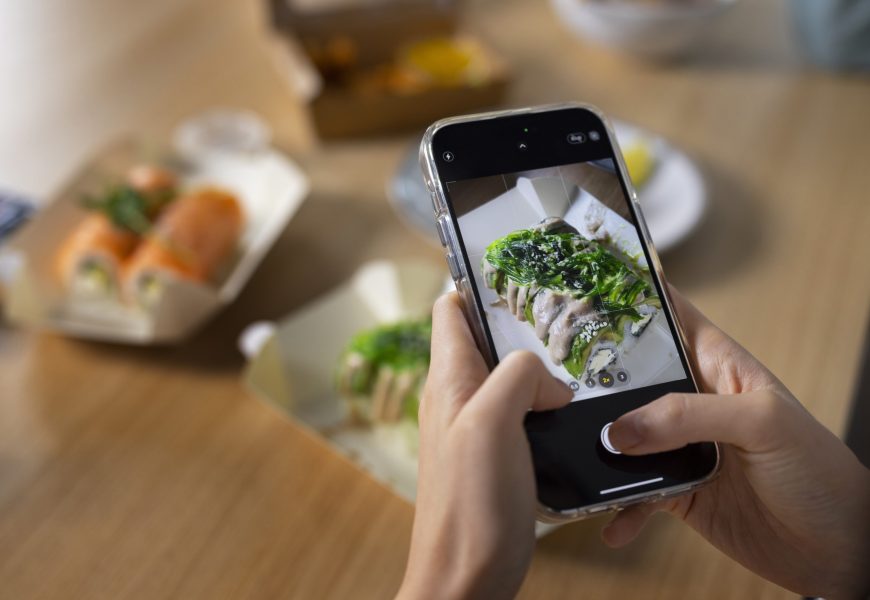Introduction
Food donation applications, along with online food app development solutions, have emerged as an effective alternative for restaurants and food businesses to address the growing issue of food waste. These apps enable businesses to give leftover food to those in need, thereby reducing waste and contributing to social good. In an era when consumers place a higher importance on corporate social responsibility, participation in food donation programs can greatly improve a restaurant’s reputation and establish deeper community relationships. This article discusses the different benefits of food donation applications for restaurants and food businesses, as well as the problems they may face and how these apps can be applied efficiently.
Understanding Food Donation Apps
Food donation applications connect food businesses with extra food to organisations or persons in need. These services are intended to simplify the process of donating food by providing features such as real-time notifications, easy scheduling, and even logistics support for food transportation. These apps use technology to help restaurants minimise waste, save money, and contribute positively to their communities.
Key Benefits for Restaurants
Reducing Food Waste
Food waste is a major issue in the restaurant sector, with vast amounts of food discarded every day. Restaurants may use food donation applications to drastically minimise the quantity of food that goes to waste. These apps enable businesses to rapidly identify leftover food and arrange for its donation, ensuring that it goes to those in need rather than ending up in a landfill. This not only benefits the environment by eliminating waste, but it also corresponds with customers’ growing desire for sustainability.
Financial Savings
Donating leftover food can result in significant financial savings for eateries. While the major benefit of food donation is to reduce waste, there are financial incentives to consider. Many regions provide tax breaks for food donations, which can help to offset some of the expenses connected with food preparation and stocking. Furthermore, by minimising trash, restaurants can reduce disposal expenses while increasing overall efficiency, resulting in a healthier bottom line.
Enhanced Community Engagement
Food donation applications provide eateries with a unique opportunity to deepen their relationships with the local community. Restaurants can make a concrete difference in their community by donating leftover food to local charities, shelters, and food banks, therefore reducing hunger and providing assistance to those in need. This act of generosity not only benefits the recipients, but also improves the restaurant’s reputation in the neighbourhood, resulting in greater customer loyalty and favourable word-of-mouth.
Positive Brand Image and Reputation
Participating in food donations can dramatically improve a restaurant’s brand image and reputation. Consumers nowadays are more aware of the social and environmental effect of their purchases, and they prefer to support firms that share their beliefs. Restaurants that frequently donate extra food might position themselves as socially responsible enterprises, attracting new customers and strengthening connections with existing ones. Positive publicity generated by food donation campaigns can also be used as a potent marketing tool, increasing company recognition and promoting goodwill.
Challenges and Considerations
Legal and Regulatory Considerations
While food donation has tremendous benefits, eateries must overcome legal and regulatory issues. Many locations have special food safety standards that must be observed while donating food, such as keeping adequate temperature controls and ensuring that the food is free of contamination. Restaurants should also be aware of liability protections, such as those granted by the Good Samaritan Food Donation Act in the United States, which protects businesses from legal action as long as the food is donated in good faith and satisfies safety standards. Understanding and following these legal standards is essential for restaurants to confidently participate in food donation programs.
Logistical Challenges
Coordinating surplus food donations can be difficult logistically, especially for perishable products that must be delivered on time. Restaurants must schedule donations, arrange for transportation, and verify that the food arrives in safe and usable shape. Food donation applications can help ease some of these issues by providing features that make the process easier, such as matching donations with nearby recipients and scheduling pickups. However, restaurants must continue to allocate resources and prepare properly to ensure that the donation process operates smoothly.
Ensuring Food Safety
Ensuring the safety of donated food is critical. To reduce the danger of foodborne illness, restaurants must adhere to strict food safety requirements. This includes proper food storage, handling, and transportation, as well as following expiration dates and other safety guidelines. Food donation apps frequently include information and recommendations to help restaurants satisfy these standards, but it is still the restaurant’s obligation to guarantee that all food donated is safe for eating. Training personnel on food donation guidelines and maintaining open contact with receiving organizations are critical elements in ensuring that gifts are both safe and profitable.
Expert Insights and Case Studies
Insights from Industry Experts
Industry experts emphasise the relevance of incorporating food donations into restaurants’ overall sustainability and CSR efforts. Successful food donation programs are those that are thoroughly integrated into the daily operations of the business, rather than being considered as an afterthought. Experts advise businesses to establish clear standards for detecting extra food, train employees on the value and practicalities of food donation, and routinely assess the effectiveness of their efforts. Technology, such as food donation apps, is crucial in making the process more efficient and productive.
Future of Food Donation Apps
Emerging Trends in Food Donation Technology
The future of food donation applications is bright, with numerous emerging features primed to increase their effectiveness and reach. One such development is the use of artificial intelligence (AI) to improve the matching process between donors and beneficiaries. AI can analyse data on food supply and demand to predict where surplus food will be available and where it will be most needed. This can result in more effective donations and reduced waste. Furthermore, there is a growing tendency towards increased openness and accountability in food donation, with apps that provide full tracking of gifts from the restaurant to the recipient. This not only assures accountability, but also enables corporations to demonstrate the good impact of their donations.
Potential for Expansion
As awareness of food waste continues to grow, there is significant potential for the expansion of food donation apps into new markets and regions. Currently, these apps are most commonly used in urban areas where there is a high density of restaurants and charities. However, there is a pressing need to expand their reach to rural and underserved areas, where food insecurity is often more acute. Expanding the network of food donation apps to these regions could have a profound impact, helping to ensure that surplus food reaches those who need it most, regardless of their location. Moreover, as more restaurants and food businesses adopt these apps, the overall volume of food donations is likely to increase, amplifying the positive effects on communities and the environment.
Innovations to Watch
Several improvements are on the horizon that could transform the way food donation apps work. One such innovation is the use of blockchain technology to improve transparency and confidence in the donation process. Blockchain, by generating an immutable record of each donation, can assure donors, receivers, and authorities that the food was handled properly and responsibly. Another intriguing development is the possible use of drone technology to transport food contributions, particularly in remote places. While still in the experimental stage, drones could provide a quick and economical means to distribute leftover food to those in need, broadening the reach and impact of food donation programs.
Practical Tips for Restaurants
Getting Started with a Food Donation App
For restaurants new to the concept of food donation, using a food donation app is a simple approach. The first step is to select an app that matches the restaurant’s needs and ideals. Many applications provide free trials or consultations to help businesses learn how their platforms work. Once an app has been chosen, restaurants should assign a point person to oversee the contribution process and ensure that all employees are informed on the protocols. Starting small, with a few donations every week, can help the business gain confidence and improve its operations before expanding. Furthermore, clear communication with receiving organizations is essential to ensure that donations fulfill their needs and standards.
Best Practices for Food Donation
To maximize the impact of food donations, restaurants should follow best practices that ensure the safety and efficacy of their contributions. This involves always adhering to strict food safety requirements, such as keeping donated food at the appropriate temperature and labeling it with all relevant information. Restaurants should also try to give food that is fresh and nutritious, avoiding goods that are about to expire or of poor quality. Regularly assessing the donation process and soliciting input from receiving organizations can help identify areas for improvement and ensure that the donations are actually beneficial. Restaurants may make significant contributions to their communities while reducing food waste by using these best practices.
Collaboration with Local Food Banks and Charities
Successful food donation campaigns frequently entail tight engagement with local food banks and charity. Establishing good partnerships with these organisations can assist guarantee that funds are used efficiently and reach people in most need. Restaurants should take the time to learn about the needs and preferences of the organisations they work with, such as the sorts of cuisine they can accept and desired delivery times. Regular communication is essential for keeping a positive and fruitful connection. Restaurants can also look at options for additional collaboration, such as participating in community events or providing volunteer assistance, to increase their influence and enhance their ties with the community.
Frequently Asked Questions
How Can Small Food Businesses Benefit from Food Donation Apps?
Small food businesses can profit from food donation applications by lowering waste, saving money, and improving their image. For enterprises with thin margins, the cash savings from decreased waste and potential tax breaks can be substantial. Furthermore, participating in food donation efforts can boost a company’s reputation and attract clients who appreciate social responsibility. Small food businesses may make a difference without depleting their resources by using food donation applications.
What Are the Legal Requirements for Food Donation?
Legal restrictions for food donations vary by location, but in general, restaurants must follow food safety rules to guarantee that donated food is safe to consume. This includes keeping food at correct storage temperatures, labelling it with essential information, and ensuring that it is not contaminated. In the United States, the Good Samaritan Food Donation Act protects businesses from liability when they donate food in good faith, as long as the food is safe. To ensure compliance, restaurants should get familiar with local rules and regulations, and consult with legal specialists as needed.
How Do Food Donation Apps Ensure Food Safety?
Food donation apps frequently offer rules and resources to help restaurants guarantee that donated food is safe to consume. These apps may incorporate temperature monitoring, expiration date tracking, and step-by-step instructions for proper food handling. Furthermore, several applications ask eateries to certify that their food satisfies safety standards before it can be given. Restaurants can reduce the risk of foodborne diseases and ensure the safety and benefit of their donations by adhering to these recommendations and using the app’s functionalities.
Can Food Donation Apps Be Integrated with Existing Restaurant Software?
Many food donation apps provide connectivity with existing restaurant software, such as POS systems and inventory management tools. This interface enables seamless tracking of extra food, making it easier for restaurants to identify things suitable for donation. Some programs also include APIs for custom integrations, which let organisations to personalise the contribution process to their own requirements. Restaurants may improve the donation process by integrating food donation apps with their existing systems, making it more efficient and successful.
Note– Enhance Your Tech Startup & Business: Connect with AG Ventures for Funding & Development Ideas!
















